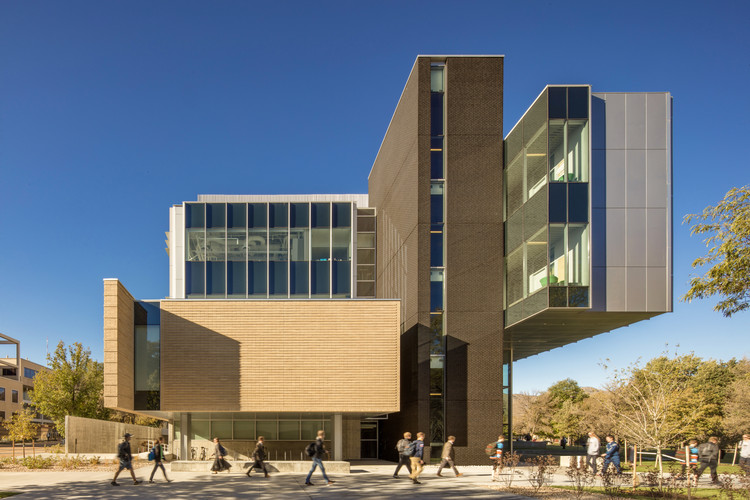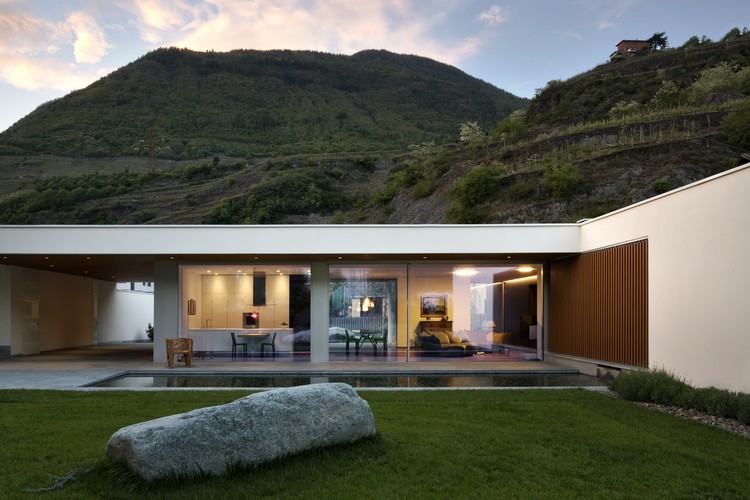Clark Court In Situ Studio
2015-07-03 13:00
© Richard Leo Johnson
理查德·利奥·约翰逊


架构师提供的文本描述。这所房子坐落在一座小山的顶上,下面有三棵大橡树,朝向一个池塘。主要内容有三层:地下室;地面入口,厨房和办公室;楼上的卧室和游戏室。窗户和天窗瞄准视野,并接纳慷慨的光线。一个展馆从主卷向西南延伸,延伸到最私人的部分。在这里,居住和就餐是在一个宽阔而又薄的屋顶下,由四根小柱子和壁炉支撑着。可操作的玻璃墙为院子打开了这个空间。房子的细长形状和细长的边缘掩盖了它的大小。
Text description provided by the architects. The house sits atop a hill, under three large oaks, and is oriented towards a pond. The main volume is three stories – basement; ground level entry, kitchen, and offices; upstairs bedrooms and playroom. Windows and skylights target views and admit generous light. A pavilion extends southwest from the main volume and onto the most private portion of the site. Here, living and dining are sheltered under a broad, thin roof supported by four small columns and the hearth. Operable glass walls open this space to the yard. The slender form of the house and thin edges belie its size.
© Richard Leo Johnson
理查德·利奥·约翰逊


我们的客户要求我们在一个突出的网站上设计一个开放的房子,这将仍然为他们提供隐私,并在内部和外部建立亲密的联系。独立的家庭办公室被添加到一个原本普通的住宅项目中。在现代和日本设计的启发下,他们要求我们追求一个简单的计划,设计一种表达节目的形式,并依靠材料和开口来表达海拔,并对景色和太阳做出反应。作为设计师,他们复杂的品味使我们能够倾向于一种富有成效的设计协作。房子的主容量包含所有私人空间和支撑元素。它主要是坚实的,虽然材料和开口的组成在海拔降低了感知的规模。
Our clients challenged us to design an open house on a prominent site that would still provide them privacy and create intimate connections between the interior and exterior. Separate home offices were added to an otherwise common residential program. Inspired by both Modern and Japanese design, they asked that we pursue a simple plan, craft a form expressive of the program, and rely on materials and openings to articulate the elevations and respond to views and the sun. As designers, their sophisticated tastes allowed us to lean into a productive design collaboration. The main volume of the house contains all private spaces and supporting elements. It is mainly solid, though the composition of materials and openings on the elevations reduces the perceived scale.
© Richard Leo Johnson
理查德·利奥·约翰逊


Ground Floor Plan


© Richard Leo Johnson
理查德·利奥·约翰逊


主卷的南端和北端可以看到池塘和森林。传统的日本语和传统的甘肃元素融入了现代的室内。一个精致的居住和就餐亭从主音量向西南延伸,远离厨房。这个空间由一个宽阔的屋顶和三棵大橡树遮住。坐落在房子和山丘之间的展馆提供了比人们想象中的玻璃盒子更多的隐私。
The south and north ends of the main volume open to views of the pond and forest. Traditional Japanese genkan and tansu elements are integrated into a modern interior. A delicate living and dining pavilion extends southwest from the main volume, off the kitchen. This space is shaded by a broad roof and three large oak trees. Nestled between the house and the hill, the pavilion provides more privacy than one would imagine within a glass box.
© Richard Leo Johnson
理查德·利奥·约翰逊


Second Floor Plan
二层平面图


© Richard Leo Johnson
理查德·利奥·约翰逊


这所房子是在混凝土地基上用木框架建造的。钢是用来实现薄,悬臂屋顶边缘和延伸南墙向池塘。房子的主体是用灰泥和当地的柏树剥皮的。相比之下,居住和就餐亭主要是玻璃,有一个薄屋顶平面,由细长的钢柱和壁炉支撑。建筑围护结构用喷雾泡沫绝缘密封。所有的机械设备都在地下室,包括地热地线的泵,高效的热泵,以及所有家庭照明和家庭自动化控制的机架系统。客厅和餐厅的楼板是由地热系统加热的,所有的照明都是LED。虽然房子里的系统很复杂,但它们的证据却被压制了。房子可以在愉快的月份开放,自然光线充足,可以代替白天的人工照明。
The house is built of a wood frame on a concrete foundation. Steel is used to achieve thin, cantilevered roof edges and extensions of the south wall towards the pond. The main body of the house is skinned with stucco and local cypress. The living and dining pavilion, in contrast, is primarily glass and has a thin roof plane supported by slender steel columns and the hearth. The building envelope is sealed tightly with spray foam insulation. All mechanical devices are in the basement, including the pumps for the geothermal ground loop, a high-efficiency heat pump, and a rack system for all home lighting and home automation controls. Slab floors in the living and dining pavilion are heated by the geothermal system and all lighting is LED. Though systems in the house are sophisticated, evidence of them is suppressed. The house can open during pleasant months, and natural light admitted is sufficient to replace artificial lighting during the day.
© Richard Leo Johnson
理查德·利奥·约翰逊






































Architects In Situ Studio
Location Raleigh, United States
Category Houses
Project Year 2013
























